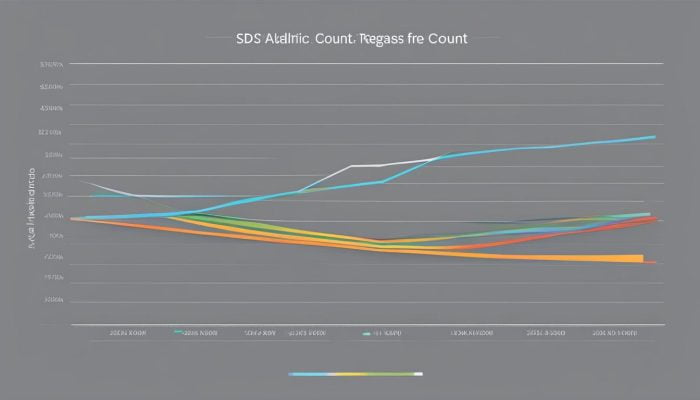Creating a well-written and optimized blog post requires knowledge of the ideal length. According to industry research and analysis, the ideal blog post length is between 1,500 – 2,500 words, with a sweet spot at 2,450 words. Different lengths serve different purposes, with shorter posts generating discussion and longer posts providing in-depth information. Factors to consider in determining the ideal length include the blog topic, target audience, goals, and the length of competing posts that are currently ranking.

Key Takeaways:
- The ideal length for a blog post is between 1,500 – 2,500 words
- Shorter posts stimulate discussion, while longer posts provide in-depth information
- Consider the blog topic, target audience, goals, and competing posts when determining length
- The sweet spot for ideal length is around 2,450 words
- Optimize your blog post length to maximize engagement and SEO performance
Blog Post Word Count and Content Depth
When it comes to blog post length, the number of words you choose can significantly impact the depth of your content. Shorter posts with less than 300 words are great for generating discussion, but they may not rank well on search engines or gain much traction on social media. Posts that range from 300 to 600 words are considered too short to rank effectively. Professional journalism and product descriptions often fall within the 600 to 800-word range. If you want to provide educational or promotional content, aim for posts between 1,300 to 2,100 words. However, the golden sweet spot for blog post length, according to search engines, is between 2,300 to 2,500 words. For thorough guides and pillar pages, posts that exceed 4,000 words offer the opportunity to cover a topic in extreme detail.

The length of your blog post should align with the depth of information you want to provide. Whether it’s a short discussion piece or an in-depth guide, the content should satisfy the needs and expectations of your target audience. Additionally, consider the goals you have for your blog post. Are you aiming to rank on search engines, drive sales, or establish yourself as an authority in your niche? By analyzing the word count of currently ranking blog posts, you can gain valuable insights into appropriate article lengths that align with your goals and stand out from the competition.
Blog Post Word Count Recommendations:
- Less than 300 words: Ideal for generating discussion, but not recommended for SEO or social media shares
- 300-600 words: Considered too short to rank effectively on search engines
- 600-800 words: Common in professional journalism and product descriptions
- 1,300-2,100 words: Ideal for educational and promotional content
- 2,300-2,500 words: The golden blog post length recommended by search engines
- Exceeding 4,000 words: Suitable for comprehensive guides and pillar pages
Remember, the ideal length for your blog post depends on various factors, including your topic, target audience, goals, and competitors’ posts. By carefully considering these factors, you can determine the appropriate length that will engage your readers, satisfy search engines, and achieve your desired outcomes.
Factors to Consider in Determining Blog Post Length
When determining the ideal length for a blog post, it is crucial to consider several factors that will ensure the content effectively engages the target audience and meets the goals of the blog post. These factors include the comprehensiveness of the blog topic, the intended audience, the goals of the blog post, and the length of competing posts that are currently ranking.
The comprehensiveness of the blog topic plays a significant role in determining the length of the blog post. Complex or technical subjects may require longer posts to provide in-depth information and satisfy the audience’s need for detailed insights. On the other hand, more straightforward topics may be adequately covered in shorter posts, focusing on concise and actionable content.
The target audience is another crucial factor to consider when determining the length of a blog post. The knowledge level, interests, and preferences of the audience should be taken into account. For instance, if the target audience consists of industry professionals seeking in-depth analysis, longer posts may be more appropriate. However, if the audience prefers quick and digestible information, shorter posts may be more effective.
Additionally, the goals of the blog post should align with its length. If the primary objective is to rank higher on search engines, longer posts that provide comprehensive information and meet the demands of search engine algorithms should be considered. On the other hand, if the focus is on driving sales or generating social media engagement, shorter and more concise posts may be more effective in capturing the audience’s attention.
Finally, analyzing the length of competing posts that are currently ranking can provide valuable insights into appropriate article lengths. Understanding the length of competing posts can help determine the optimal length that stands out among competitors while providing valuable information to the audience.
| Factors to Consider | Details |
|---|---|
| Comprehensiveness of the blog topic | Complex topics may require longer posts, while simpler ones can be covered in shorter posts. |
| Target audience | Consider the knowledge level, interests, and preferences of the audience. |
| Goals of the blog post | Align the length with the intended goals, such as SEO ranking or driving sales. |
| Length of competing posts | Analyze the length of currently ranking posts to gain insights into appropriate article lengths. |
By considering these factors, bloggers can make informed choices about the length of their blog posts, ensuring that they effectively engage their audience and achieve their goals.
Benefits of Long-Form Blog Posts
Long-form blog posts, generally over 1,000 words, offer several benefits for SEO and engagement. These longer posts allow for more in-depth exploration of a topic, providing comprehensive and well-researched information to readers. By offering valuable insights and detailed explanations, long-form content keeps readers engaged, leading to increased time spent on page.

Furthermore, longer posts have a higher chance of generating backlinks and social shares. When readers find value in a blog post, they are more likely to share it with their network, expanding the reach and visibility of the content. Backlinks, which are links from other websites to your blog post, are a key factor in search engine rankings. Longer and more comprehensive blog posts are more likely to earn these backlinks from other authoritative sources.
The Benefits of Long-Form Blog Posts
“Longer posts lead to increased time spent on page, generate more social shares and backlinks, and improve SEO performance.”
From an SEO perspective, long-form blog posts provide the opportunity to target and rank for a wider range of keywords. With more content, there are more opportunities to naturally incorporate keywords and related terms, which can boost the visibility of the post in search engine results. Additionally, longer posts often cover a topic more comprehensively, which aligns with search engine algorithms’ preference for high-quality and informative content.
Overall, long-form blog posts have proven to be an effective strategy for improving SEO, increasing reader engagement, and establishing authority in a specific niche. While they may require more time and effort to create, the benefits they provide in terms of visibility, shares, and backlinks make them a valuable addition to any content marketing strategy.
| Benefits of Long-Form Blog Posts | |
|---|---|
| Increased time spent on page | Longer posts provide more opportunities for readers to engage with the content, leading to longer visit durations. |
| More social shares | Well-researched and valuable long-form content is more likely to be shared by readers on social media platforms, increasing its reach and visibility. |
| More backlinks | Long-form blog posts that provide comprehensive information are more likely to earn backlinks from other authoritative websites, improving the blog’s authority and trustworthiness. |
| Improved SEO performance | Longer posts offer more opportunities to incorporate relevant keywords and cover a topic comprehensively, increasing the chances of ranking higher in search engine results. |
Downsides of Long-Form Blog Posts
While long-form blog posts have their benefits, there are also some downsides to consider. Writing long-form content can be time-consuming for both the writer and the reader. It requires extensive research, planning, and organization to deliver a comprehensive piece of content. Additionally, readers may be hesitant to commit to reading a lengthy post, especially if they are looking for quick answers or information.
Another downside is the challenge of promoting and sharing long-form blog posts on social media. Due to their length, they may not receive as much engagement or visibility compared to shorter, more concise posts. It can be difficult to capture the attention of social media users who are accustomed to scrolling through their feeds and consuming bite-sized content.
Furthermore, writing longer posts increases the risk of losing focus or digressing from the main point. It requires careful planning and structuring to maintain a clear and coherent flow throughout the entire post. Without proper organization, long-form content can become overwhelming and fail to deliver its intended message effectively.
| Pros | Cons |
|---|---|
|
|
Despite these downsides, long-form blog posts can still provide valuable and in-depth information to the audience. It is important to strike a balance between length and engagement, ensuring that the content is well-written, precise, and valuable to the reader.
Determining the Ideal Blog Post Length
When it comes to determining the ideal length for a blog post, there are several factors to consider. These factors include the blog topic, the target audience, the goals of the blog post, and the lengths of competing posts that are currently ranking. By analyzing these factors, bloggers can make informed decisions about the length of their posts.
The first factor to consider is the comprehensiveness of the blog topic. Some topics may require more in-depth coverage, while others can be adequately addressed in a shorter format. It’s important to assess the level of detail needed to provide valuable information to the audience.
The second factor is the intended audience. The knowledge level and preferences of the audience can influence the ideal length of a blog post. For example, a more technical audience may appreciate longer, more detailed posts, while a general audience may prefer shorter, more concise content.

Next, the goals of the blog post should be considered. Is the goal to rank on search engines, drive traffic, or increase conversions? The length of the blog post should align with these goals. Longer posts may be better suited for SEO purposes, while shorter posts may be more effective for generating engagement and social media shares.
Lastly, it’s important to analyze the lengths of currently ranking blog posts. This can provide insights into the article lengths that are performing well in the competitive landscape. By considering the lengths of successful posts, bloggers can gauge the ideal length for their own content.
Table: Comparison of Blog Post Lengths and Their Effects
| Blog Post Length | Effects |
|---|---|
| Shorter than 300 words | Good for generating discussion but not suitable for SEO or social media shares. |
| 300-600 words | Considered too short to rank on search engines but acceptable for certain purposes like professional journalism or product descriptions. |
| 600-800 words | Common in professional journalism, suitable for providing concise and informative content. |
| 1,300-2,100 words | Ideal for educational and promotional content, allowing for more in-depth coverage. |
| 2,300-2,500 words | The golden range for blog post length according to search engines, providing a balance between comprehensive information and reader engagement. |
| Longer than 4,000 words | Suitable for pillar pages and thorough guides, offering extreme detail on a topic. |
The Role of Long-Form Blog Posts in SEO
When it comes to optimizing your blog for search engines, long-form blog posts play a crucial role. Search engines prioritize trustworthy and well-researched content, and longer posts provide the opportunity to delve into a topic in-depth. By providing comprehensive information, long-form blog posts have a higher chance of ranking in search engines and driving valuable traffic to your website.
Longer posts also give bloggers the opportunity to cover topics using various formats such as lists, guides, and demonstrations. These formats not only make the content more engaging and visually appealing but also allow you to target different keywords and search intents. By providing valuable and in-depth information, long-form blog posts can satisfy user queries and establish your blog as a reliable source of information.

Benefits of Long-Form Blog Posts:
- Improved SEO Performance: Long-form blog posts provide more opportunities to include relevant keywords and cover a broader range of related topics, increasing the chances of ranking for highly searched terms.
- Increase in Time Spent on Page: Long-form content tends to keep readers engaged for longer periods, signaling search engines that your content is valuable and encourages them to rank it higher.
- Establishing Authority and Expertise: In-depth and well-researched long-form posts position you as an authority in your niche, increasing the likelihood of attracting backlinks and social shares from other respected sources.
Downsides of Long-Form Blog Posts:
- Time-Consuming: Writing longer posts requires more time and effort, both for the writer and the reader.
- Promotion Challenges: Longer posts may be more difficult to share and promote on social media platforms due to their length and level of detail.
- Potential Loss of Focus: There is a risk of losing focus or digressing from the main point when writing longer posts. It’s important to maintain a clear structure and keep the reader engaged throughout.
While there are downsides to consider, long-form blog posts can still provide valuable and in-depth information to your audience. By carefully crafting your content and balancing length with engagement, you can leverage the benefits of long-form blog posts to boost your SEO performance and establish your authority in the industry.
The Benefits of Longer Blog Posts
When it comes to blog post length, longer posts have several advantages that can greatly benefit bloggers. Here are some reasons why longer blog posts can be beneficial:
- Comprehensive Information: Longer posts allow bloggers to cover a topic in-depth, providing readers with valuable and comprehensive information. This can make the content more valuable and increase the chances of it being shared and linked to by other websites.
- Establishing Authority: Longer blog posts can help establish the writer as an authority in their field. By providing well-researched and detailed information, bloggers can showcase their expertise, gaining the trust and respect of their audience.
- SEO Performance: Search engines value long-form content that provides detailed and valuable information to users. Lengthier blog posts have a higher chance of ranking for widely searched keywords, attracting organic traffic and improving SEO performance.
- Increased Engagement: Longer blog posts tend to generate higher engagement levels compared to shorter posts. Readers spend more time on page, which can signal to search engines that the content is relevant and of high quality. Longer posts also provide more opportunities for readers to comment, share, and interact with the content.
Overall, longer blog posts offer the opportunity to deliver comprehensive and valuable information to readers, establish expertise and authority, as well as improve SEO performance. By considering the benefits of longer blog posts, bloggers can make informed choices about the length of their content and create a more impactful and successful blog.

Pros and Cons of Long-Form Blog Posts
Long-form blog posts have become increasingly popular in recent years due to their numerous advantages. However, it is important to weigh the benefits against the potential downsides before committing to this format. Let’s take a closer look at the pros and cons of long-form blog posts.
Pros of Long-Form Blog Posts
- Comprehensive Coverage: Long-form blog posts allow you to delve deep into a topic, providing your readers with detailed and valuable information. This comprehensive coverage can establish you as an authority in your niche and attract a loyal following.
- Higher SEO Performance: Search engines tend to favor longer content that provides in-depth knowledge. By creating long-form blog posts, you increase your chances of ranking higher in search engine results pages, driving more organic traffic to your website.
- Establishing Expertise: Long-form blog posts provide you with the opportunity to showcase your expertise and establish yourself as a thought leader in your industry. This can help build trust with your audience and elevate your brand’s reputation.
Cons of Long-Form Blog Posts
- Time-Consuming: Writing long-form blog posts requires more time and effort compared to shorter formats. Researching, organizing, and crafting extensive content can be challenging and time-consuming, especially if you have a busy schedule.
- Potential for Reduced Social Sharing: Long-form blog posts may not receive as many social shares as shorter, more digestible content. This is because lengthy articles can be perceived as intimidating or time-consuming to read and share on social media platforms.
- Focus and Attention: With longer posts, there’s always a risk of losing focus or digressing from the main point. It’s essential to maintain a clear and structured flow throughout the article to ensure that readers stay engaged and don’t lose interest midway.

While long-form blog posts have their advantages, they may not be suitable for every blog or topic. Consider your audience, goals, and available resources before deciding on the length of your blog posts. Striking a balance between providing valuable information and maintaining reader engagement is key to creating successful long-form content.
| Pros of Long-Form Blog Posts | Cons of Long-Form Blog Posts |
|---|---|
| Comprehensive coverage | Time-consuming |
| Higher SEO performance | Potential for reduced social sharing |
| Establishing expertise | Focus and attention |
Ultimately, the decision to use long-form blog posts should be based on a careful evaluation of your specific circumstances and goals. Consider your audience’s preferences, your available resources, and the nature of the topic you wish to cover. By considering the pros and cons outlined above, you can make an informed decision that aligns with your blogging strategy.
FAQ
How long should a blog post be?
The ideal blog post length is between 1,500 – 2,500 words, with a sweet spot at 2,450 words.
What factors should be considered in determining the ideal blog post length?
Factors to consider include the blog topic, target audience, goals, and the length of competing posts that are currently ranking.
What are the benefits of long-form blog posts?
Long-form blog posts improve SEO performance, generate more social shares and backlinks, and establish the writer as an authority in the field.
Are there any downsides to using long-form blog posts?
Writing long-form content can be time-consuming and may not receive as many social shares as shorter content. There is also a risk of losing focus or digressing from the main point.
How can I determine the ideal length for my blog post?
The ideal length should be determined based on the comprehensiveness of the topic, the intended audience, the goals of the blog post, and the lengths of currently ranking blog posts.
What role do long-form blog posts play in SEO?
Long-form blog posts are prioritized by search engines as they provide trustworthy and well-researched content. They also have a higher chance of ranking for widely searched keywords.
What are the benefits of longer blog posts?
Longer blog posts lead to increased time spent on page, generate more backlinks and social shares, and improve SEO performance by providing comprehensive information.
What are the pros and cons of long-form blog posts?
The advantages include covering topics comprehensively, generating backlinks, and establishing expertise. However, longer posts may require more time and effort to write and may not receive as many social shares.
How should I determine the length of my blog post?
Analyze the blog topic, target audience, goals, and the lengths of currently ranking blog posts to make an informed decision about the length of your post.
Conclusion
After considering various factors, such as the blog topic, target audience, goals, and competitors’ posts, determining the ideal blog post length requires careful analysis. While there is no universally perfect length, longer posts have been found to provide numerous benefits in terms of SEO, social sharing, and establishing expertise. In order to meet the needs of their audience and achieve their goals, bloggers should strive to deliver valuable and comprehensive content.
Blog posts play a crucial role in SEO performance, as search engines prioritize well-researched content that provides in-depth information. Longer posts allow bloggers to cover topics comprehensively and offer various formats, such as lists, guides, and demonstrations. By providing valuable and comprehensive information, long-form blog posts have a higher chance of ranking in search engines and driving valuable traffic to the website.
While there are downsides to consider, such as the time and effort required to write longer posts and the potential difficulty in promoting them, the benefits of long-form content outweigh these drawbacks. Longer posts generate more time spent on page, increase social shares and backlinks, and improve SEO performance. It is crucial to strike a balance between length and engagement, ensuring that long-form content remains well-written, precise, and valuable to the reader.
In conclusion, finding the ideal blog post length is a strategic decision that should align with the blog topic, target audience, and goals. By considering these factors and striving to deliver valuable and comprehensive content, bloggers can optimize their blog posts for SEO, social sharing, and establishing expertise in their field.